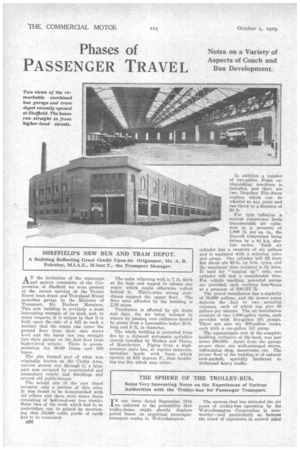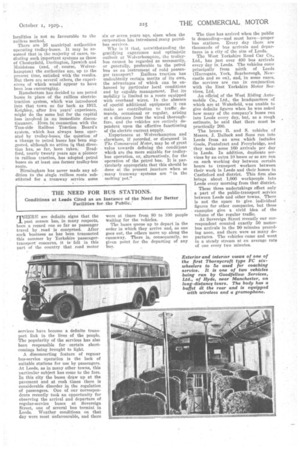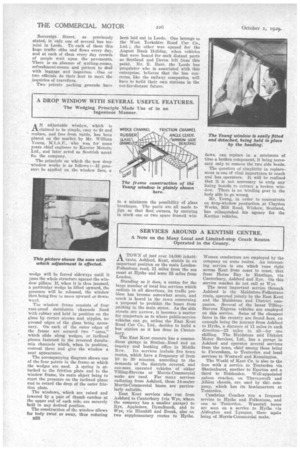THE SPHERE OF THE TROLLEY-BUS.
Page 70

Page 71

Page 72

If you've noticed an error in this article please click here to report it so we can fix it.
Some Very Interesting Notes on the Experiences of Various Authorities with the Trolley-bus for Passenger Transport.
TN our issue dated September 17th l_we -referred to the probability that trolley-buses might shortly displace petrol buses on municipal passengertransport routes in Wolverhampton. The success that has attended the six years of trolley-bus operation by the Wolverhampton Corporation . is noteworthy—and particularly so because the trend of experience in several other localities is not so favourable to the railless method.
There are 16 municipal authorities operating trolley-buses. It may be assumed that in the majority of eases, including such important systems as those of Chesterfield, Darlington, Ipswich and Maidstone (and, of . course, Wolverhampton) the authorites are, up to the Present time, satisfied with the results. But there are several others, the experiences of which would appear to have been less encouraging.
Ramsbottom has decided to use petrol buses in place of the Tailless electrictraction system, which was introduced into that town so far back as 1913. Keighley, after five years' experienee, might do the same but for the capital loss involved in an immediate discontinuance. Even in connection with the Tees-side Railless Traction Board's system, which. has. always been operated by trolley-buses, the question of a -change to petrol buses has been sire.gested, although no action in that diree den has, so far, beentaken. Bradford, nearly twenty years ago a pioneer in railless traction, has adopted petrol buses du at least one former trolley-bus route.
Birmingham has never made any addition to the single .railless_ route 'substituted for. a tramway service some six or seven years ago, since when the corporation has introduced many petrolbus services.
Why is it that, notwithstanding the gratifying experience and optimistic outlook at Wolverhampton, the trolleybus cannot be regarded as necessarily, or generally, preferable to the petrol bus as an instrument of road passen ger transport? 'tailless traction has undoubtedly certain merits of its own, the advantages of which can be enhanced by p,articular local conditions and by capable management. But its mobility is limited to a route equipped with overhead wires. In the absence of special additional equipment it can make no contribution to traffic demands, occasional or regular, arising at a distance from the wired thoroughfare, and the vehicles are entirely dependent upon the effective functioning of the electric current supply.
• Experiences at Wolverhampton and elsewhere, if recorded, or -discussed in The Commercial Motor, may be of great value towards defining the conditions which are the more suitable for trolleybus operation, or, alternatively. for the operation of the petrol bus. It is particularly appropriate that this should be done at the present juncture when so ; many tramway • systems are "in the melting pot.7 The time has arrived when the public is demanding—and must have—proper bus stations. Every day there are thousands of bus arrivals and departures in a city of the size of Leeds.
The West Yorkshire Road Car Co., Ltd., has just over 400 bus arrivals every day in Leeds. The vehicles come principally from mirth of Leeds (Harrogate, York, Scarborough, Newcastle and so on), and, in some cases, the services are run in conjunction with the East Yorkshire Motor Services, Ltd. • An official of the West Riding Automobile Co, Ltd., the headquarters of which are at Wakefield, was unable to give definite figures when he was asked how many of the company's buses run into Leeds every day, but, as a rough estimate, he said that there must be practically 290.
The brown B. and S. vehicles of Messrs. J. Bullock and Sons run into Leeds froman area which includes' Goole, Pontefract and Ferrybridge, and they make some 160 arrivals per day ' in Leeds. In addition, duplicate services -by an extra 10 buses OX so are run on each working day between certain hours to transport workers between their work in Leeds and their homes in Castleford and district. This firm also brings about 1,000 workpeople into Leeds every morning from that district.
These three undertakings effect only a part of the public-transport service between Leeds and other towns. There is not the space to give individual figures for other companies, but these examples give a vivid idea of the volume of the regular traffic.
At Sovereign Street recently our correspondent counted exactly 50 motorbus arrivals in the 90 minutes preceding noon, and there were as many departures. The vehicles came and went in a steady stream at an average rate of one every two minutes. Sovereign Street, as previously stated, is 'only one of several bus termini in Leeds. To each of them this huge traffic ebbs and flows every day, and at each of them every day crowds of people wait upon the pavements. There is an .absence of waiting-rooms, refreshment-rooms and porters to deal with luggage and inquiries-. One or two officials do their best to meet the inquiries of travellers.
Two private parking grounds have been laid out in Leeds. One belongs to the West Yorkshire Road Car Co., Ltd.; the other was opened for the August Bank Holiday, when vehicles that were bound for such distant parts as Scotland and Devon left from this point. Mr. R. Barr, the Leeds bus proprietor who is associated with this enterprise, believes that the bus concerns, like the railway companies, will have to build their own stations in the not-far-distant future.






















































































































